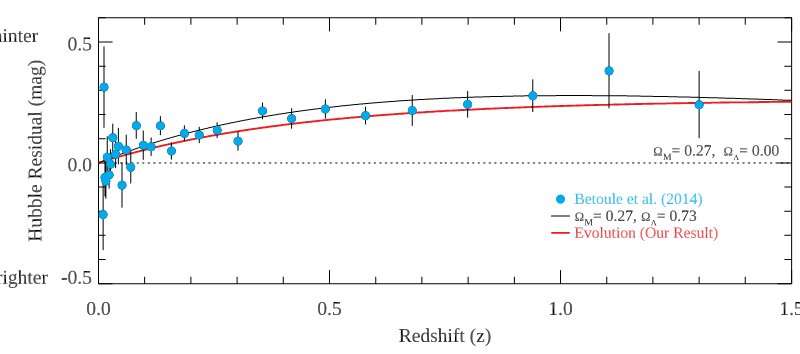
The most direct and strongest evidence for the accelerating universe with dark energy is provided by the distance measurements using type Ia supernovae (SN Ia) for the galaxies at high redshift. This result is based on the assumption that the corrected luminosity of SN Ia through the empirical standardization would not evolve with redshift.
New observations and analysis made by a team of astronomers at Yonsei University (Seoul, South Korea), together with their collaborators at Lyon University and KASI, show, however, that this key assumption is most likely in error. The team has performed very high-quality (signal-to-noise ratio ~175) spectroscopic observations to cover most of the reported nearby early-type host galaxies of SN Ia, from which they obtained the most direct and reliable measurements of population ages for these host galaxies. They find a significant correlation between SN luminosity and stellar population age at a 99.5 percent confidence level. As such, this is the most direct and stringent test ever made for the luminosity evolution of SN Ia. Since SN progenitors in host galaxies are getting younger with redshift (look-back time), this result inevitably indicates a serious systematic bias with redshift in SN cosmology. Taken at face values, the luminosity evolution of SN is significant enough to question the very existence of dark energy. When the luminosity evolution of SN is properly taken into account, the team found that the evidence for the existence of dark energy simply goes away (see Figure 1).
Commenting on the result, Prof. Young-Wook Lee (Yonsei Univ., Seoul), who led the project said, "Quoting Carl Sagan, extraordinary claims require extraordinary evidence, but I am not sure we have such extraordinary evidence for dark energy. Our result illustrates that dark energy from SN cosmology, which led to the 2011 Nobel Prize in Physics, might be an artifact of a fragile and false assumption."
Other cosmological probes, such as the cosmic microwave background (CMB) and baryonic acoustic oscillations (BAO), are also known to provide some indirect and "circumstantial" evidence for dark energy, but it was recently suggested that CMB from Planck mission no longer supports the concordance cosmological model which may require new physics (Di Valentino, Melchiorri, & Silk 2019). Some investigators have also shown that BAO and other low-redshift cosmological probes can be consistent with a non-accelerating universe without dark energy (see, for example, Tutusaus et al. 2017). In this respect, the present result showing the luminosity evolution mimicking dark energy in SN cosmology is crucial and very timely.
This result is reminiscent of the famous Tinsley-Sandage debate in the 1970s on luminosity evolution in observational cosmology, which led to the termination of the Sandage project originally designed to determine the fate of the universe.
This work based on the team's 9-year effort at Las Campanas Observatory 2.5-m telescope and at MMT 6.5-m telescope was presented at the 235th meeting of the American Astronomical Society held in Honolulu on January 5th (2:50 PM in cosmology session, presentation No. 153.05). Their paper is also accepted for publication in the Astrophysical Journal and will be published in January 2020 issue.
Explore further
Provided by Yonsei University
Citation: New evidence shows that the key assumption made in the discovery of dark energy is in error (2020, January 6) retrieved 6 January 2020 from https://phys.org/news/2020-01-evidence-key-assumption-discovery-dark.html
This document is subject to copyright. Apart from any fair dealing for the purpose of private study or research, no part may be reproduced without the written permission. The content is provided for information purposes only.
https://news.google.com/__i/rss/rd/articles/CBMiSWh0dHBzOi8vcGh5cy5vcmcvbmV3cy8yMDIwLTAxLWV2aWRlbmNlLWtleS1hc3N1bXB0aW9uLWRpc2NvdmVyeS1kYXJrLmh0bWzSAUhodHRwczovL3BoeXMub3JnL25ld3MvMjAyMC0wMS1ldmlkZW5jZS1rZXktYXNzdW1wdGlvbi1kaXNjb3ZlcnktZGFyay5hbXA?oc=5
2020-01-06 12:42:05Z
CAIiEDZEI4u6E4k3eLM0eC_IXMEqFwgEKg8IACoHCAowpbDpAzCm_hwwj9kp
Tidak ada komentar:
Posting Komentar